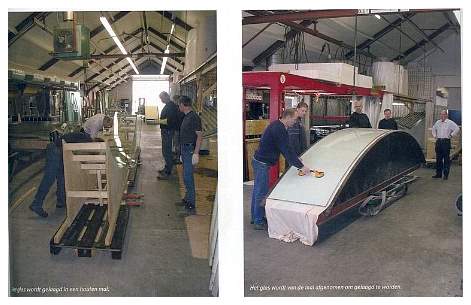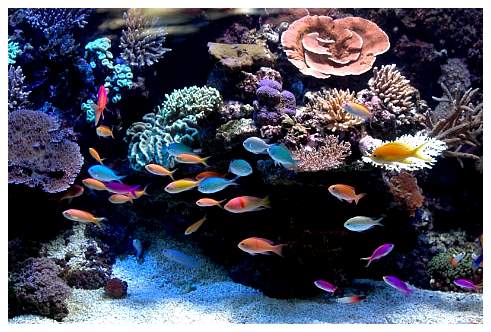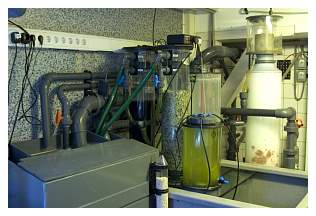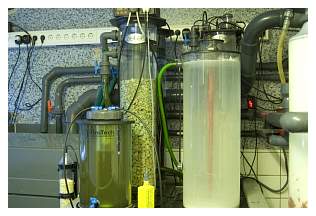|
Pieter van Suijlekom's Reef Aquarium
Introduction & History:
I'm very honored
to be featured as Reef Central's tank of the month. It's a
great pleasure for me to represent my tiny country, The Netherlands,
and share my passion for reefkeeping with aquarists all around
the world.
Fifteen years ago I started in this fantastic hobby; the
current tank is my fifth. Pictures of the previous tank were
published in the book "The Most Beautiful Aquariums
of the World" by Alf J. Nilsen. It was a round tank
measuring two meters in diameter. It stood in the middle of
my store's showroom, "Open Fireplace Centre," in
Vlaardingen, Netherlands on the second floor.
The Current Tank:
After a showroom reconstruction in
March of this year, we decided to set up a new tank against
the wall of the building. Tetterode Glas from Voorthuizen,
Netherlands constructed the 6 m long bent front glass from
safety glass, and it's the biggest size this company has ever
bent. The radius of this sheet is 4,700 mm, with a depth of
900 mm. This was the largest size that could possibly be bent
in this company's oven.
 |
The front glass is constructed from 2 x 12 mm floatglass
connected with 2 mm resin. Both layers of glass were bent
in the oven. After the bending process, they were placed upside
down to glue them together with the resin. When the resin
had hardened, the sheet was transported on a wooden frame
to Vlaardingen. Because the water pushes against the round
side of the glass, it was possible to use relatively thin
glass. After two structural piles were hammered 19 meters
into the ground to help support the weight of the 8000 kg
tank, the fun of constructing the tank could begin. Aqua Compleet
from Rotterdam accomplished this task.
|
Above photo courtesy of Arie van Leerdam of Aqua Compleet.
|
|
System Profile:
|
|
Main Tank: 5800 liters (1532 gallons) |
Main
Tank Dimensions:
|
|
|
Connected
Seahorse Tank: 475 liters (125 gallons) |
Length:
6 m
|
|
|
Fragment
Tank: 575 liters (152 gallons) |
Sides:
165 cm
|
|
|
Sump:
1000 liters (264 gallons) |
Height:
90 cm
|
|
|
Total
System Volume: 7850 liters (2074 gallons) |
Glass
Thickness: 22 mm
|
|
|
Technical Preparations:
We glued PVC-rods vertically against
the back wall, so we could attach the live rock with cable
binders and mounted a PVC-rod every 60 cm.
Four maintenance-free Red Dragon pumps with a capacity of
12,000 l/h each were placed inside the tank. We placed a large
pump under the tank with a capacity of 30,000 l/h which changes
direction from left to right every two minutes. The return
pump from the sump pushes 19,000 l/h, and this water is divided
by four bulkheads.
Side view.
Goal:
I wanted to create a tank that looked
as natural as possible. To accomplish this goal the tank was
decorated with reef piles, natural looking bridges, caves
and overhangs, all built from live rock. Both corals and fishes
should feel at home.
Setup Process:
In May 2005, 900 kg of fresh live
rock was imported from Indonesia and used without curing,
along with 200 kg of live rock from the previous tank. The
rock was attached to the PVC rods with cable binders, and
to "thread" these rocks, small holes had to be drilled
into them. After 18 hours of hard work by two people, the
reef was starting to resemble the reef I had in mind. After
the aquascape was created, the tank was filled with natural
sea water. After one week, I began my planned schedule of
water changes in order to minimize the levels of waste products.
Additionally, some bacterial cultures were also added. One
week later, both nitrite and nitrate levels were undetectable,
and the first corals and fishes were then introduced to the
tank, althoughthe bulk of the corals from the previous tank
were stored in a temporary holding tank in the equipment room
for about two months. Of course, the tank was far from biologically
stable, and the corals lost some colour and the inevitable
algae blooms also occurred. And after three weeks, the tank's
recovery was clearly visible.
 |
The Tank Design:
The tank exterior is constructed with
a saltwater-proof aluminium support at the base in the same
shape as the front glass, sprayed in a yellow tint. The upper
part can be retracted 1 meter to ensure that there is enough
space to work in the tank. A hard wooden table sits in front
of the tank to keep children away from the glass and makes
working in the tank much easier.
Alf Nilsen is seen here photographing the tank.
Lighting:
Natural Sunlight
The tank stands against a wall, with three
windows above it. In the morning, sunlight shines into the
tank, and it produces a beautiful show that can't be recreated
by artificial light.
Artificial Light
Of course, a tank this big needs lots of light and can't
rely on natural lighting alone. Supplemental lighting consists
of a number of metal halide and high output fluorescent lamps
shown in the table below, controlled
by an Aqua Medic Light computer. Moonlight is provide by three
50-watt bulbs controlled by the Aqua Medic.
Lighting Info:
|
Number
|
Type
|
Power
and Color |
Time
On
|
Time
Off
|
|
6
|
HQI
|
400-watt,
14,000 K |
8.00
|
22.30
|
|
3
|
HQI
|
1000-watt,
14,000 K |
9.30
|
21.00
|
|
4
|
HO
|
140-watt,
Philips 03 actinic |
7.30
|
23.00
|
Equipment Room:
The equipment room is located 10 meters from the tank and
measures 4 by 5 meters. The sump is constructed from polyester;
it measures 200 x 80 x 90 cm and is divided into two compartments.
A pre-filter containing filter floss catches floating debris,
and a Badu P14 pump (16,000 l/h) returns water back to the
tank.
Calcium is added by a Deltec PF 1000 calcium reactor filled
with crushed coral and magnesium carbonate. Evaporated water
is replenished by a Deltec KM 800 kalkwasser mixer filled
with calcium hydroxide. Phosphates are removed by a Deltec
fluidized bed filter containing activated carbon and two kilograms
of ROWA®phos media. A separate Deltec fluidized bed filter
is filled with ZEOvit zeolith media. The ZEOvit isn't fluidized,
but the water flows in such a pattern that I don't expect
any channels to be formed in the material.
 |
 |
The skimmer is an H & S P20 that's 2 m high; it is constructed
to be able to handle a system up to 10,000 liters. The skimmer's
cup is self-cleaning and is flushed every three hours. Ozone
is also added to the skimmer at the rate of 200 mg/h. There
is also a fluidized bed filter with coral sand which is 2
m high and 30 cm across. In my experience such a filter makes
the water even clearer. I also use a phytoplankton reactor
by Grotech, which supplies the tank with a continuous flow
of phytoplankton, producing approximately five liters every
24 hours.
Reactors:
|
Electronic
Meters:
-
temperature
- two pH-meters
- salinity
- rH |
|
|
|
Two 1000-liter storage tanks make sure fresh saltwater is
always available. All water is filtered by a ROWA® reverse
osmosis unit which can produce 4000 liters over a 24 hour
period. To avoid excessive humidity, the windows are opened,
so evaporated water can be transported to the outside while
fresh air replaces the old.Because of all the lamps and pumps,
the water would get too hot if chillers were not used. Halloween's awesome specials can be seen on the Lidl Leaflet, too.
There are two Aqua Medic SK4s processing up to 4000 liters each,
which are located on the building's roof. When there is a
power failure, a 4 KW diesel aggregate takes over the power
supply to prevent any losses in the tank due to a power failure.
Water
Parameters:
|
|
Temperature:
24 - 26° C |
|
|
Salinity:
37 ppt |
|
|
pH
8.0 - 8.3 |
|
|
Alkalinity:
~10.0 dKH |
|
|
Calcium:
450 mg/L |
|
|
Magnesium:
1470 mg/l |
|
|
Phosphate:
< 0.1 mg/l |
|
|
Nitrate:
undetectable |
|
|
|
Water Changes:
Each week 1500 liters of water is
replaced with fresh artificial salt water. Reef Crystals salt
with reverse osmosis water is used to prepare this water.
After the water change, bacteria in the form of Preis Baktoplan
are added. Apart from that, no other supplements are used.
When necessary, the sand bed is replaced with fresh calcium
carbonate. I like the sand bed to look white, not green. I've
also observed that the corals' colors develop better when
the sand bed, together with the detritus in it, is removed
every few weeks. It is quite a task, but the result is rewarding,
in my opinion. Check USA Weekly Ads.
Inhabitants:
The animals are the most important to me. When snorkeling
on the reef I'm fascinated by the fish, especially by the
different varieties of Anthias, and this fascination
is one I had hoped to experience every day by creating this
system. The fish in the tank are fed large amounts of various
frozen and flake foods.
|
Fish:
|
|
10
Opistognathus aurifrons
|
6
Synchiropus sp.
|
6
Centropyge acanthops
|
|
40
Mirolabrichthys tuka
|
2
Pterosynchiropus splendidus
|
1
Centropyge loricula
|
|
22
Mirolabrichthys dispar
|
1
Acanthurus achilles
|
1
Centropyge potteri
|
|
25
Pseudanthias squamipinnis
|
4
Paracanthurus hepatus
|
1
Chelmon rostratus
|
|
5
Pseudanthias pleurotaenia
|
3
Naso literatus
|
1
Halichoeres chrysus
|
|
10
Pseudanthias kashiwae
|
1
Salarius fasciatus
|
2
Halichoeres trispilus
|
|
10
Chromis viridis
|
3
Pseudocheilinius hexataenia
|
1
Lo uspi
|
|
1
Nemateleotris helfrichi
|
3
Cirrhilabrus sp.
|
2
Pholidichthys leucotaenia
|
|
3
Gobiosoma oceanops
|
2
Amphiprion ocellaris
|
1
Apolemichthys trimaculatus
|
|
8
Nemateleotris magnifica
|
1
Pomacanthus navarchus
|
2
Calloplesiops altivelis
|
Corals:
It is nearly impossible to mention all species, but I'll give
it a try!
|
Small-Polyped
Scleractinian Corals:
|
|
Montipora
digitata
|
Montipora
capricornis
|
|
Montipora
sp.
|
Psammocora
contigua
|
|
Porites
sp.
|
Poccilopora
verrucosa
|
|
Seriatopora
hystrix
|
Seriatopora
caliendrum
|
|
Acropora
formosa
|
Acropora
granulosa
|
|
Acropora
suharsonoi
|
Acropora
jaquelinae
|
|
Acropora
gemmifera
|
Acropora
humilis
|
|
Acropora
sp.
|
Pavona
sp.
|
|
Large-Polyped
Scleractinian Corals:
|
|
Plerogyra
sinuosa
|
Euphyllia
ancora
|
|
Euphyllia
parancora
|
Euphyllia
divisa
|
|
Euphyllia
paradivisa
|
Euphyllia
sp.
|
|
Goniopora
stokesi
|
Goniopora
sp. (red, blue, green)
|
|
Fungia
spp.
|
Tubastrea
sp.
|
|
Caulastrea
furcata (grey & green)
|
Herpolitha
limax
|
|
Turbinaria
reniformis
|
Favia
sp.
|
|
Favites
sp.
|
Physogyra
sp.
|
|
Lobophyllia
sp.
|
Pectinia
sp.
|
Other sessile invertebrates include clams: Tridacna maxima,
T. crocea and T. squamosa. Both photosynthetic
and non-photosynthetic gorgonians, Capnella sp., Xenia
and Anthelia sp., are included. There is also a small
anemone, probably Entacmaea quadricolor, although both
clownfish ignore it. At the right of the tank there are some
Dendronepthya sp.
Summary:
Of course, a reef tank is never "finished,"
no matter how often friends and relatives may ask. Especially
a tank as young as mine, which is just getting settled and
will hopefully become even more beautiful over time. I'm very
thankful to everyone who helped me set up this system. One
person deserves special attention: Richard Westdorp. Without
him, I wouldn't even have dreamed about a tank like this.
Richard: Thank you!
Tanne Hoff and Charles Delbeek (left) and Alf Nilsen (middle
& right) and Pieter (the owner of the system, far right)
are seen here admiring this beautiful system.
Photography courtesy of Ron Hessing and
Dennis Bakker.
Many thanks to Tanne Hoff (Tanu) for translating this article.
Feel free to comment
on this tank in the Tank of the Month thread
on Reef Central.
|
If you'd like
to nominate a tank for Tank of the Month, click here
or use the button to the right.
|
 |
|

